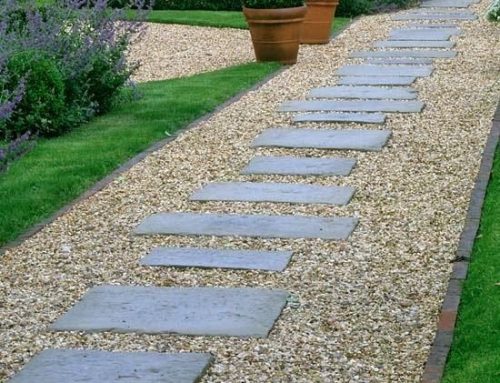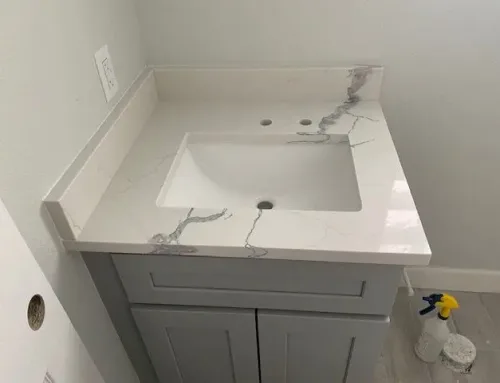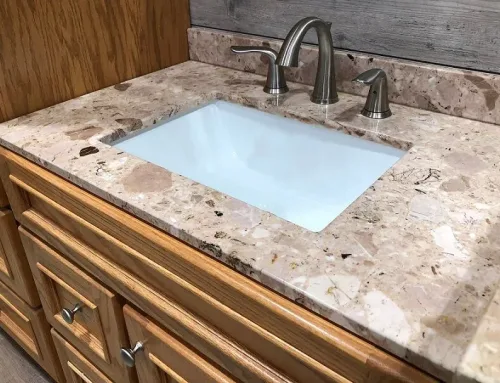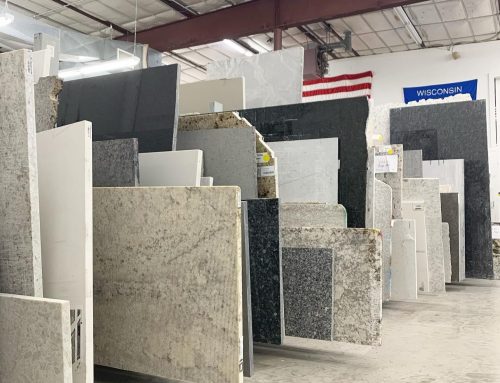What finish should countertops be? When selecting new countertops for your home, one of the key decisions is choosing the right finish. The finish not only impacts the aesthetics of the surface but also influences maintenance, durability, and functionality. Whether you’re installing granite, quartz, marble, or another material, the right finish can enhance both the look and practicality of your countertops. Here’s a breakdown of the most popular countertop finishes and how to choose the best one for your space.
1. Polished Finish
A polished finish is the most common and popular choice for countertops. It offers a glossy, reflective surface that enhances the natural colors and patterns of the material.
Pros:
- Increases stain resistance by sealing the pores of natural stone.
- Easy to clean and maintain.
- Adds a luxurious, high-end look.
Cons:
- Can show smudges, fingerprints, and water spots more easily.
- May require periodic resealing, especially for natural stone.
2. Honed (Matte) Finish
A honed finish has a smooth, matte surface with little to no reflection. This finish is ideal for those who prefer a soft, muted look.
Pros:
- Hides scratches and water spots better than a polished finish.
- Provides a natural and understated appearance.
- Less reflective, reducing glare.
Cons:
- More prone to staining due to its slightly porous nature.
- Requires regular sealing, especially for materials like marble and limestone.
3. Leathered Finish
A leathered finish provides a textured, slightly rough surface that adds depth and dimension to the stone. It is commonly used for granite and quartzite countertops.
Pros:
- Hides fingerprints, smudges, and watermarks well.
- Offers a unique, tactile feel with a natural look.
- Requires less maintenance than a honed finish.
Cons:
- Can be harder to clean due to the textured surface.
- Not available for all countertop materials.
4. Satin Finish
A satin finish falls between honed and polished. It has a soft sheen without being too glossy or too matte, offering a balanced appearance.
Pros:
- Provides a smooth touch with minimal reflection.
- Easier to maintain than honed finishes.
- Offers a contemporary, sophisticated look.
Cons:
- May not be as resistant to stains as polished finishes.
- Still requires regular sealing for natural stone materials.
5. Brushed Finish
A brushed finish gives the countertop a slightly worn, aged look with soft texture. It is similar to a leathered finish but with more variation in texture.
Pros:
- Durable and low maintenance.
- Adds character and depth to the stone.
- Ideal for rustic and industrial-style kitchens.
Cons:
- Can be harder to clean due to the uneven surface.
- Less common, which may limit options.
Choosing the Right Finish for Your Space
When deciding on a countertop finish, consider the following factors:
- Usage: If you have a high-traffic kitchen, a polished or satin finish may be more practical due to ease of cleaning.
- Aesthetics: For a modern and sleek look, polished countertops work best, while honed and leathered finishes offer a softer, more natural appearance.
- Maintenance: If you want low maintenance, opt for polished or satin finishes. For a more textured and unique look, consider leathered or brushed finishes.
- Material: Some materials naturally work better with certain finishes. For example, marble looks elegant with a honed finish, while granite and quartzite shine with a leathered or polished finish.
Final Thoughts
So what finish should countertops be? The finish of your countertop plays a crucial role in both its appearance and durability. Whether you prefer the glossy appeal of a polished surface, the subtle elegance of a honed finish, or the rugged charm of a leathered texture, your choice should align with your lifestyle, aesthetic preferences, and maintenance considerations. By understanding the pros and cons of each finish, you can select the best option to enhance your kitchen or bathroom space for years to come.





